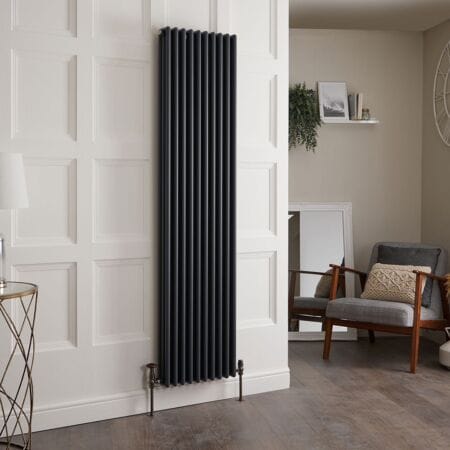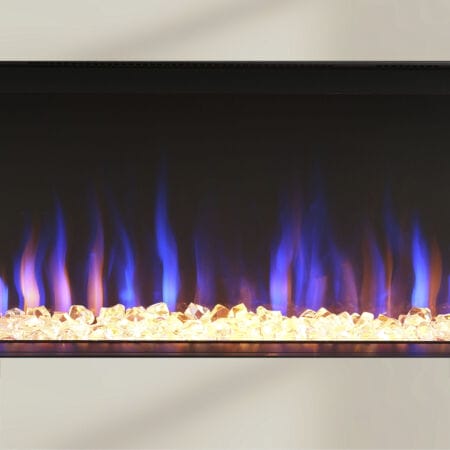Ah, the charm of period property or loft apartment high ceilings, light, airy, and undeniably beautiful. But come winter, that same grandeur can leave you feeling like you’re heating a cathedral instead of a home! With this in mind and the cost of heating on the rise, we’ve assembled a guide packed with expert tips and trusted solutions to keep your high-ceilinged haven warm and cosy without breaking the bank. Here’s how to heat rooms with high ceilings efficiently.
Contents
ToggleWhat we’ll cover…
- What is considered a high ceiling
- Challenges of heating high-ceilinged rooms
- Expert tips and cost-effective solutions to heating rooms with high ceilings
What is considered a room with high ceilings?
In a standard UK home, any room with a ceiling over 3 meters is considered a high ceiling with the average floor to ceiling height being 2.4m. Taller rooms tend to also have larger windows which impacts the heating requirements as we will cover shortly.
Challenges of heating a room with high ceilings
Unlike their modest counterparts, high-ceilinged rooms present a greater challenge:
Larger volume
Simply put, there’s more air to heat in a room with high ceilings, demanding extra effort from your HVAC system. The increased surface area of walls and ceilings creates more opportunities for heat to escape, hindering efforts to maintain a comfortable temperature. This can strain efficiency and lead to higher energy bills.
Convection currents
Warm air, as we know, rises. This leaves a pocket of warmth near the ceiling, while the rest of the room remains chilly. Have you ever turned up the thermostat, yet your toes remained stubbornly cold? That’s convection, leaving you feeling chilly despite the high heat setting. This not only makes your home feel uncomfortable, but also leads to skyrocketing energy consumption and costs. In other words, the high-ceiling heating struggle is real.

How to heat a room with high ceilings
So, what can you do to combat the chill and heat your room efficiently? The key to conquering the cold in your high-ceilinged home lies in a multi-step approach. Let’s tackle this from the ground up:
1. Improve your insulation
Before you even think about heating, ensure your home is well-insulated. Start with your loft, it’s the biggest culprit for heat loss because heat rises! That’s why it is so important to prevent heat escaping through the roof to save you from paying for heating that doesn’t warm you up. The good news? The UK government currently offers grants to help with loft insulation costs under the ECO scheme.
Cavity wall insulation
Don’t forget cavity wall insulation. According to Energy Saving Trust, about a third of heat is lost through the walls if your home isn’t insulated properly. It wasn’t until the 1980s when new laws were created making cavity wall insulation a legal requirement.
So, if you live in an older property, you might not have any cavity wall insulation. You can check by looking at your loft insulation. If it is non existent it is likely that your cavity walls don’t have any either. Contacting a reputable insulation installer is the best thing to do in this case.
DIY insulation
For something quick, easy and cost effective, DIY draught-proofing around windows, doors, and chimneys is a must. Simple jobs like applying sealant to windows and filling floorboards or using a draught excluder will make a huge difference when heating any size space. Every little bit counts!

2. Choose the right heating system
The right boiler
If your high ceiling rooms still feel cold with the heating on, your central heating boiler might need an upgrade. Combi boilers offer hot water on demand, while traditional boilers require a separate hot water cylinder. Consider replacing older models with energy-efficient options. Take a look at our boiler upgrade guide for more advice.
The right thermostat
Smart thermostats allow for clever scheduling and further optimize your energy consumption. They provide the ability to programme heating schedules to suit your home life for better energy management. This is particularly useful as you can set the heating to come on first in rooms with taller ceilings to allow them longer to warm up before you get home.
The right radiators
Traditional radiators, especially real cast iron ones, are excellent for heat retention in high-ceilinged rooms. The cast iron columns are designed to stay warmer for longer, even after the heating is turned off.
It’s also crucial to calculate the BTU ‘British Thermal Unit’ requirements of your room to ensure your living space is heated comfortably. The BTU calculator uses room dimensions, window size and wall material to work out the BTUs your radiator needs to provide.
This helps you compare radiators and see which size you need for your room with high ceilings. Vertical radiators offer high BTU outputs and the tall design makes use of the height of the wall creating a stylish statement in space which would have been wasted.
The right underfloor heating
Underfloor heating provides a luxurious, evenly distributed warmth. As we mentioned warm air rises. So having a ground heat source like electric underfloor heating is a great way to ensure you always have toasty toes instead of just a scorching ceiling! However, consider factors like floor type and potential installation challenges. Find out more in our underfloor heating guide.

3. Maximise heat circulation
Once you’ve got a good heat source, you need to ensure it reaches you effectively. Not just the space above you!
Effective fan use
If you have a ceiling fan, don’t underestimate its power! In winter, reverse the blade direction to a slow, clockwise rotation. This pulls cool air up and gently pushes warm air from the ceiling down towards you. While this method might be less effective with extremely high ceilings, it can significantly reduce heating costs in many cases.
Strategic vent management
Since heat rises, rooms upstairs tend to be warmer. If you have unbalanced airflow or unused rooms, partially close vents in those areas to redirect heat towards occupied spaces with open vents. Avoid completely closing vents, as this can damage your HVAC system. The safety way to direct heat in rooms with high ceilings is to partially shut some vents.
4. Embrace electric radiant heat
Radiant heat warms objects and surfaces directly, instead of just the surrounding air which rises when warmed. How it works? Our dry heat thermal radiators, ceramic core radiators, infrared panel heaters and electric radiators feature thermal elements that produce radiant heat to push heat into the room creating a comfortable and even temperature distribution. These eco-friendly and efficient electric heating solutions emit a higher proportion of radiant heat compared to hot water radiators. Ideal for keeping some of the heat lower down in rooms with high ceilings.
5. Bonus heat boosting tips
For an extra layer of comfort, consider these additional heating strategies for high ceilings:
Layer up your floors
Thick rugs add an extra layer of insulation on cold hard floors, providing warmth underfoot and enhancing the cosy atmosphere. Wool rugs tend to offer the best insulation. Plus, they look and feel beautiful in a variety of interior styles.
Dress your windows
Heavy curtains act as a barrier against heat loss. Hang thick curtains on windows in rooms with high ceilings to help retain heat and add an elegant feature that further elongates the room.
Close the doors!
It might sound incredibly obvious, but closing the doors in high ceiling rooms can help to focus the heating on occupied areas to keep the warm air in.
Let the sunlight in
Open curtains and blinds during the day to allow the sun’s natural warmth to bathe your space. Remember to keep windows tightly closed to prevent drafts, and ensure curtains don’t obstruct radiators or vents.

Invest in comfort, not high heating costs
By implementing these strategies for how to heat rooms with high ceilings, you can transform your high-ceilinged home into a warm and inviting haven without breaking the bank. Remember, a focus on insulation and efficient heating systems goes a long way in saving money on energy bills in the long run.
At BestHeating our expert team is here to help you conquer the quest for cosy high ceiling spaces! We offer a range of heating solutions, from tall designer radiators to efficient electric models. Plus, expert advice on optimizing your current system. Let’s turn up the comfort, not the bills!
Jess has a passion for interior design and wants to inspire people to look at radiators as home decor. She enjoys keeping on top of the latest design and heating trends to ensure the Advice Centre has all the information and inspiration homeowners need to make the best choice for them.




